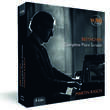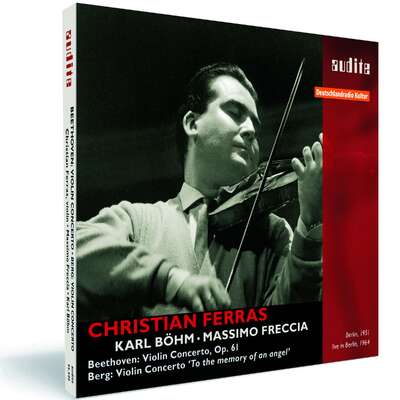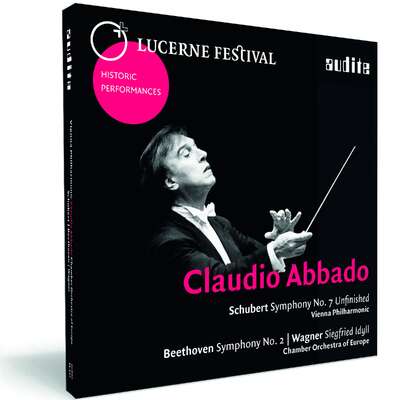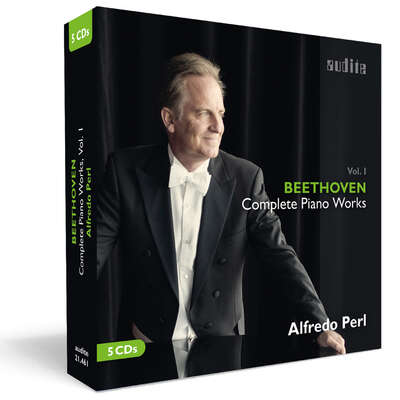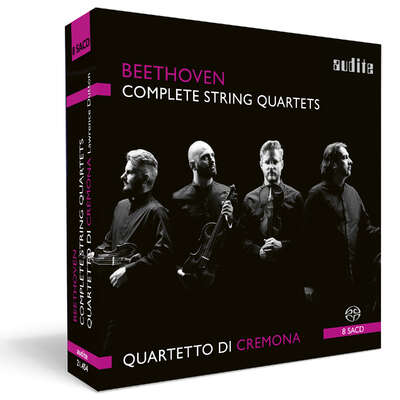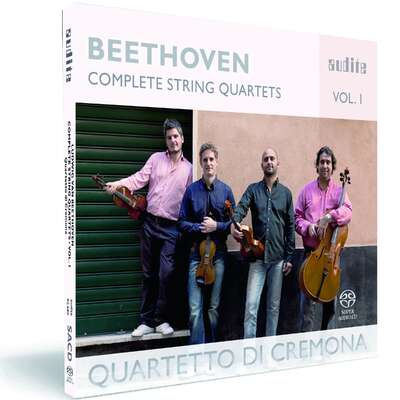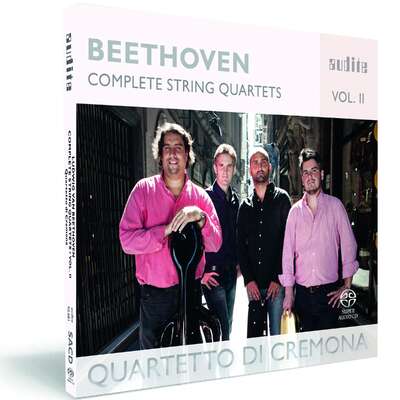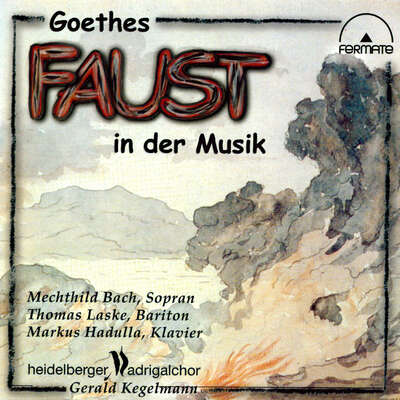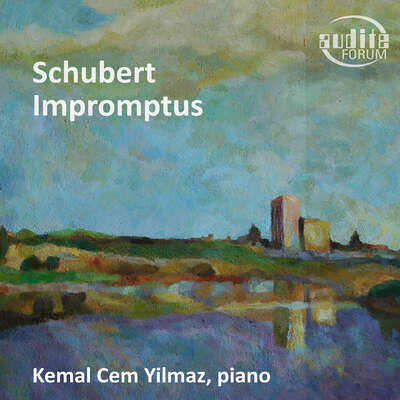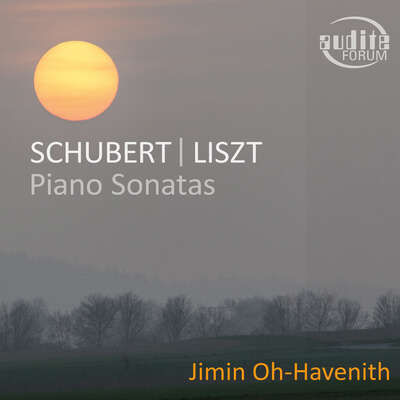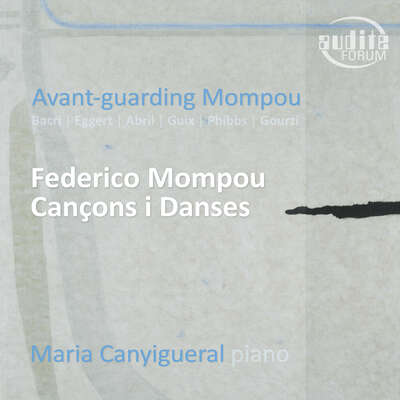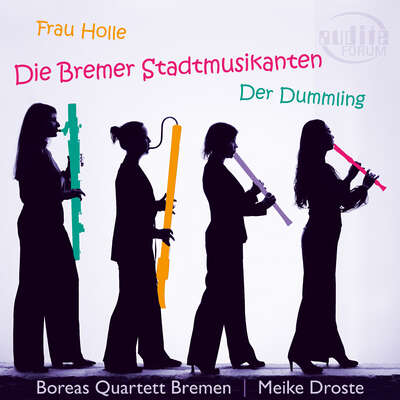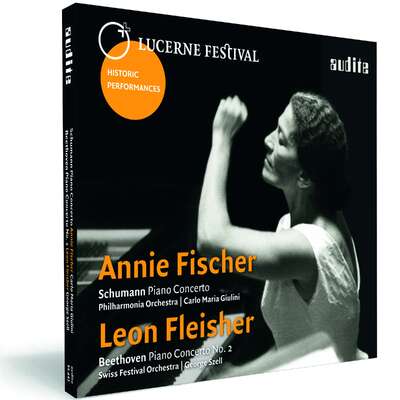
A Cosmos in Movement - Beethoven’s thirty-two piano sonatas: Worlds upon worlds, strange constellations, collisions, destruction and creation, coherent laws and mysterious forces. The cosmos of Beethoven’s piano sonatas is in movement, a “work in progress”. Beethoven internalized this revolutionary, dynamic new world view, and it also forms the basis for his creative aesthetic.more
A Cosmos in Movement - Beethoven’s thirty-two piano sonatas: Worlds upon worlds, strange constellations, collisions, destruction and creation, coherent laws and mysterious forces. The cosmos of Beethoven’s piano sonatas is in movement, a “work in progress”. Beethoven internalized this revolutionary, dynamic new world view, and it also forms the basis for his creative aesthetic.
Track List
Details
| Ludwig van Beethoven: The Complete Piano Sonatas | |
| article number: | 21.451 |
|---|---|
| EAN barcode: | 4022143214515 |
| price group: | BCT |
| release date: | 24. November 2017 |
| total time: | 647 min. |
Bonus Material
Informationen
A Cosmos in Movement: Beethoven's thirty-two piano sonatas
Worlds upon worlds, strange constellations, collisions, destruction and creation, coherent laws and mysterious forces: The cosmos of Beethoven's piano sonatas is in movement, a "work in progress," or as Beethoven's favorite philosopher Immanuel Kant wrote, "always occupied with bringing forth new things and new worlds." Beethoven internalized this revolutionary, dynamic new world view, and it also forms the basis for his creative aesthetic: From the three sonatas Op. 2 dedicated to Haydn and rooted in the Classical tradition to the final movement of Op. 111, where the "artless song" of the Arietta undergoes a unique process of rhythmic transformation in which it seems to be completely liberated from time and space. The critic Adolf Bernhard Marx, who was sympathetic to Beethoven, was no longer able to follow, but still found the fitting words for this final point of culmination: "At the end of the finite, the eternal reveals itself."
Reviews
jpc-courier | 12/2019 | December 1, 2019 Kurz informiert und Highlights
»Diese Beethoven-Sonaten-Gesamteinspielung ist insgesamt bemerkenswert, da man nur selten eine so ausgeglichene, überzeugende und saubereMehr lesen
www.ClassicsToday.com | 27.07.2018 | Jen Distler | July 27, 2018 | source: https://www.clas... Big Box from Hell: Martin Rasch’s Pedantic Beethoven Cycle
Martin Rasch is a pianist in his mid-40s who teaches at Munich’sMehr lesen
www.musicweb-international.com | Monday March 12th | Roy Westbrook | March 12, 2018 | source: http://www.music...
Martin Rasch is a German pianist born in 1974 who studied with Gerhard Oppitz and others in Munich. He professes a penchant for the live performanceMehr lesen
The earliest of these sonatas are from 1795, and it’s easy to forget that the first dozen of Beethoven’s thirty-two sonatas are works of the 18th century. The first three sonatas are dedicated to Haydn, who still had over a decade to live. How far should the playing style reflect the fact that they belong to Haydn’s Vienna, and are the work of a man in his late twenties making his way in that world? It’s perhaps tempting to play them in effect “with hindsight”, anticipating the drama and profundities to come in the middle and late periods. Martin Rasch largely avoids this, and keeps things in the right scale and style for the 1790s, even though he is using a modern Steinway concert grand piano. Disc one sets just this tone of decorum.
The first publication in the series, Op.2, is a set of three sonatas. Op.2/1, with a neat and tidily articulated opening Allegro, a slow movement that is not all that slow, a steady minuet and a Prestissimo that is not very fast. Op.2/2 is a bigger work with a 7-to-8 minute Largo appassionato which again flows nicely, taking 7:14. Charles Rosen, in his book on the sonatas, tells us that Beethoven slow movements have got slower, due to modern instruments that can sustain better, bigger concert halls, and a sense of reverence for Beethoven that leads artists to feel slow tempi are needed to reveal his profundity. Later works maybe, but not those of the 1790s surely. The largest of the set is Op.2/3 (the total timing is 28:14), in which Beethoven really wants to draw attention to his skill. Here the slow movement is a dramatic piece and Rasch responds to its rhetoric without once overdoing it. The finale, too, is very nicely played, even the triple trill in the cadenza, which the composer must have put there to show off his own keyboard dexterity.
Op.7 is “one of the longest and most difficult of the thirty-two” (Rosen), and only the Hammerklavier sonata is usually any longer than its half hour span. The opening Allegro con brio bristles with technical hazards which Martin Rasch negotiates with skill and musicality, qualities in evidence in the following movements also. The great Largo con gran espressione has much, if not quite all, of the “grand expression” the marking asks for, while the minuet and the finale are fine. Op.10 is another publication of three sonatas, of which Op.10/3 in D major is the largest, being the only one with four movements. It opens with a Presto, and this is taken at just the right tempo to provide the necessary momentum but let each incident make its point. The Largo e mesto evokes the deepest feeling so far in the cycle and if the tempo here is a bit on the slow side (though many are slower still), there is the right degree of pathos. The Menuetto is also lyrical, beginning dolce as marked but still dance-like, and the Rondo finale is done with some sense of fun, even if one has heard others make more of its range of mostly comic moods.
With the Pathétique (Op.13) we enter new territory in terms of the fame and popularity of the work, and therefore the likelihood that any collector of Beethoven sonata discs will already own several versions. If this one is unlikely to displace your particular favourite, it is a more than creditable account with a properly flowing tempo for the exquisite Adagio cantabile. More could have been made of the ensuing Rondo though. But at least there is a sense that with the Pathétique, we are still in the 18th century. Op.22 in B flat is also from 1799, and has never enjoyed the popularity of its predecessor, though the composer seems to have been rather proud of his accomplishment here. Rasch clearly regards it as highly as any sonata so far, bringing his steady seriousness of manner, especially to the Adagio con molto espressionne. Beethoven does rather less with the Viennese conventions of both the minuet and finale of Op.22, and Rasch recognises that in the propriety of his playing of them. And so we bid farewell to the 18th century.
The A flat sonata Op.26 begins with a set of variations, each of which might have been more distinctly characterised, and Rasch might have made more of the several switches to quieter playing (subito piano). But he does maintain a steady tempo through the variations, holding the movement together well. The Marcia funebre is a true funeral march but still at a march pace, not too dirge-like. Of the pair of Op.27 sonatas, both styled “quasi una fantasia”, it is the second (the Moonlight) which comes off the better. Not so much for its opening Adagio sostenuto, which lacks something in moonlit magic compared to many other versions, but for its charming Allegretto and a rollicking Presto agitato. The Pastorale Op.28 is another named sonata, not as celebrated as the Pathétique or the Moonlight perhaps but bigger than either, needing 25:41 here for its four movements. Rasch again thinks that a famous moniker requires no special treatment (he could be right of course), so that there is nothing very pastoral about the opening movement that, unusually for Beethoven, slightly outstays its welcome at ten and a half minutes. The Andante is in a march tempo which Rasch keeps moving very attractively, while the pastoral finale with a drone bass is done in a suitably rustic manner.
The Op.31 is another set of three, of which the D minor second sonata (“The Tempest”) is among the best known of the middle period, and the greatest of the sonatas up to this point. Fortunately it also gets the best performance up to this point in Rasch’s cycle. The opening material in Rasch’s hands has the drama the writing demands, especially in the leaping bass figure and the pleading soft reply, where he gets a real dynamic contrast, and the start of the development, which has the essential improvisatory feel. The great finale has the driven quality its perpetual motion needs without becoming over-driven, and the whole performance suggests the work might be more central to Rasch’s repertory, played outside full cycles. Op.31/3 is a comparable success, with an appealing ebullience in the scherzo and the skipping tarantella of the Presto con fuoco finale.
With the quintessential middle-period sonatas, the Waldstein Op.53 and the Appassionata Op.57, we arrive at two of the greatest, and most popular, of all works for the piano, let alone Beethoven sonatas. Martin Rasch for the most part rises to their considerable demands as far as technique goes, if not always with the ideal temperament. In the opening movement of the Waldstein, the pulse for the first subject is a proper Allegro con brio and as button-holing as it should be. The recapitulation is immediately preceded by some slight hesitation of pulse, or if it is a moment of rubato it is not very welcome in such a driven piece. The finale is more solid than spectacular perhaps, though Rasch copes well with the many technical demands of the long Prestissimo coda. The Appassionata is a similar story, with powerful, dramatic, accurate playing, but not quite heaven-storming enough in the outer movements. The lower emotional temperature of Op.78 and Op.79 suit Rasch better on this evidence, for they are both given joyful performances.
The sonata Les Adieux Op.81a sets off on its journey with a horn call – a three note motif over which the composer wrote the three syllables ‘Le-be-wohl’ or ‘farewell’ in German. But Rasch gives no sense of a programme in the piece, rather downplaying the drama behind the notes. The finale (‘The Return”) is marked Vivacissimamente – in a very lively manner. What we get is surely modified rapture at best, not so much a matter of the speed as of the absence of brightness of articulation or a lift to the rhythm. He doesn’t sound all that excited about this return. Op.90 is from 1814, and the composer had been writing piano sonatas for twenty years. Its status is one of being in between the middle and late sonatas, as is that of the following sonata Op.101 of 1816. Op.90 is well brought off by Rasch in the first movement. He sees it as a middle period work, with no attempt at the searching qualities of the final works. The lyricism of the second and final movement finds him a bit matter of fact, but better that than nudging the delightful main theme into sounding more laden with meaning than it is.
Op.101 is a four-movement work which some pianists apparently consider the most difficult sonata to play, but Rasch gives no sign of that. Indeed it is another one of the most convincing interpretations in the set. The first movement grows and flows quite naturally through to its close, and the dotted rhythms of the second movement have a Schumannesque spring in their step. The preludial slow movement is affecting and the big finale’s fugal passage has an insouciant air that suits it well. It is followed on disc 8 by the imposing opening of Op.106, the Hammerklavier sonata.
There is a notorious controversy over the right tempo for the first movement of the Hammerklavier, coming from a muddle over the composer’s metronome mark. Personally I like the Schnabel and Pollini approach – going for as fast a tempo as the music will bear but which will still permit clean articulation (though Schnabel does not always manage this). But broader tempi, like that Rasch adopts here, can work too of course (and are more commonly heard), and this Allegro is pretty convincing. The brief scherzo is despatched with aplomb, and the great slow movement – one of the composer’s finest attempts at the sublime – does not lose its grip over its long (18:49) span. The fugal finale is an imposing and satisfying account if not quite a jaw-dropping tour-de-force. But it’s marked Allegro risoluto, and his resolute tempo and manner gives Rasch space to let us hear what is actually going on in the massive fugue. It would make a good version from which to get to know this amazing sonata.
The last three sonatas (Op.109 – Op.111) are all among the successes of this recorded cycle. The elusive first movement of Op.109 holds together well, and the theme and variations of its finale are expertly explored, yielding a cumulative eloquence. This continues into Op.110, the easiest of the last three to get to know and love, perhaps. Rasch sounds as if he loves it rather than merely reveres it. He certainly offers a fine account. The last work of all, Op.111, was called by Thomas Mann “the end of the sonata” – implying there was nothing left to say once Beethoven had explored the form over thirty-two infinitely varied examples. It certainly feels that way if you hear it after four days spent listening to its predecessors from one artist, as I have just done. It shows, too, that Rasch can use an extreme tempo when he feels it is really justified. He begins the wonderful Adagio molto semplice e cantabile with the utmost gravity, but still semplice. At the end of this immense traversal, he wants us to take time, and in this performance of the work, time stands still. It crowns a fine achievement by Rasch.
Martin Rasch comes across in the set as the dutiful servant of this music. His interpretations are central, rarely individual or eccentric. He sounds determined to be self-effacing in the cause of this great art. He has no particular mannerisms in his playing. There is often a steadiness of tempo in fast movements and flowing relative swiftness for slower movements, avoiding extremes either way. He has the technique to encompass the demands – which are not exactly negligible – of all these works, if occasionally suggesting that they can still be taxing. But a sense of struggle is a part of the aesthetic, at least from the middle period on. Others with more transcendental piano techniques can make the sonatas sound easy, too easy perhaps. Throughout the set he never condescends to what might be seen as the lesser works, but brings the same seriousness to them as to the big favourites. This is a valuable asset in a complete cycle.
No artist can ever tell us all that this music has to say. This is a very good set, if not quite one to upset the prevailing rankings, where Brendel’s third cycle (the digital one) stands out. I have a personal soft spot for Kovacevich’s cycle too, which is the one I think Rasch’s perhaps most resembles. Among other recent cycles, there are at least two that have been less noticed than they deserve. Michael Korstick on Oehms has much to offer in the more famous works among the thirty-two, as well as sometimes more individuality in the wrong sense of more extremes (a world-record 28-minute Hammerklavier adagio!). I especially like Mari Kodama on Pentatone, who is very straight in the same way as Rasch, sometimes with more dash to the pianism. Both of these have excellent SACD sound, the Pentatone perhaps the best ever given to these works. (But only the Pentatone retains the SACD mastering in the boxed set version, while Oehms offers only CDs in the box.) Many will also want a cycle on a period instruments, and another SACD series, Ronald Brautigam’s on BIS, will allow you to hear how different they might have sounded to their composer, and at various points reveal what he really meant us to hear. All of these cost several times more than the Audite box.
But for those looking for a (very affordable) way into these inexhaustible works, Martin Rasch’s cycle never misrepresents any work among the thirty-two. He does justice to each one, and he depicts them in proper relation to each other across this astonishing career-long journey. But he is more than just a reliable guide, he is often also a persuasive advocate.
www.good-music-guide.com | February 10, 2018 | Todd | February 10, 2018 | source: http://www.good-...
A brand new LvB cycle of the super-budget variety. [...] Sound quality is fully modern. It is always clear, with some recordings a bit closer than others.Mehr lesen
ionarts.blogspot.com | December 01, 2017 | jfl | December 1, 2017 | source: http://ionarts.b... Beethoven Sonatas – A Survey of Complete Cycles Part 9, 2014-2016
[…] A Munich-based project from Audite; a bit of a surprise of a release that smells of "Executive-producer-knows-pianist-in-question-very-well".Mehr lesen
This listing of all Beethoven Sonata Cycles will continue as more sets reach completion or as I find more information about sets already completed.* There are certainly plenty sets under way that should or may reach completion soon: Among them Angela Hewitt (Hyperion), Igor Tchetuev (Caro Mitis), Jonathan Biss (Onyx), Akihiro Sakiya (DPIC Entertainment), Martin Roscoe (Deux-Elles), James Brawn (MSR), Paavali Jumppanen (Ondine) [Completed & Added], Yusuke Kikuchi (Triton) [Completed & Added] et al. I will also add a selection of historically important attempted cycles that were never finished but include >20 >9 sonatas. That would add Rudolf Serkin (CBS, 10 sonatas missing), Bruce Hungerford (Vanguard / Piano Classics, also 10 sonatas missing), Emil Gilels (DG, opp. 2/1, 14/1, 54, 78, 111), and Glenn Gould (CBS/Sony, opp. 7, 22, 49, 53, 79, 81a, 90 missing, op. 106 separate, opp. 7 [partly], 49/1, 101 available on CBC recordings). There are seemingly abandoned cycles that will not be included, such as those of Giovanni Belluci, Bruno Leonardo Gelber, Yoshihiro Kondo, or Per Tengstrand. There are cycles that are unworthy of discussion or outright fraudulent, i.e. not actual piano playing and/or of excrutiating quality and/or cobbled together from other performances. Most famously Joyce Hatto, but apparently also Vladimir Morrone, Giancarlo Andretti, Alicja Kot, and Claudio Colombo.**
*If you count, as I did, Backhaus II and Arrau II as complete, despite one and two (respectively) missing sonatas. I do not count Walter Gieseking (tapes of 4, 5, 7, 20, 22 for a radio cycle are lost, a studio cycle for EMI was missing seven sonatas when he died), Wilhelm Kempff "0" (Polydor, opp. 2/3, 22, 27/1, 28, 31/2, 101 missing).
**Invaluable research on this end done by Todd, resident Beethoven-Sonata expert (and addict) at the Good Music Guide Forum.
Straubinger Tageblatt | 24.11.2017 | Werner Haas | November 24, 2017
Seltene Ausgewogenheit
Martin Rasch spielt alle Sonaten von Beethoven in einer CD-Box ein
Kennzeichnend für Raschs Klavierspiel ist eine selten anzutreffende Ausgewogenheit zwischen Texttreue und emotionaler Ebene [...] Diese Box mit neun CDs ist wärmstens zu empfehlen – ein Muss für alle Beethovenenthusiasten.Mehr lesen
Piano News | September / Oktober 5/2018 | Carsten Dürer Facettenreicher Blick auf Gilels, Bernstein als Pianist und Rasch mit Beethoven
Diese Beethoven-Sonaten-Gesamteinspielung ist insgesamt bemerkenswert, [...] da man nur selten eine so ausgeglichene, überzeugende und saubere Interpretation der Beethoven-Sonaten zu hören bekommt.Mehr lesen
